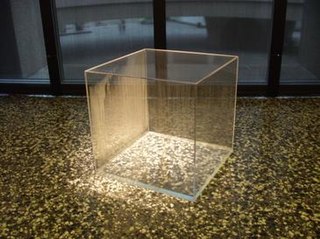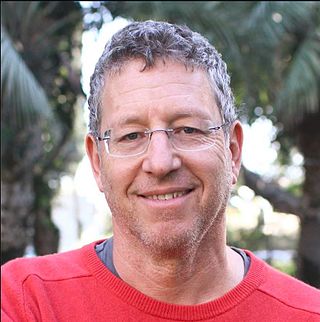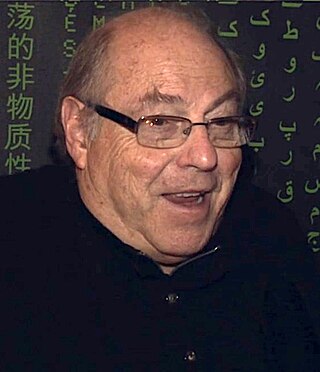
Computer science is the study of computation, information, and automation. Computer science spans theoretical disciplines to applied disciplines. Though more often considered an academic discipline, computer science is closely related to computer programming.

Sir Charles Antony Richard Hoare is a British computer scientist who has made foundational contributions to programming languages, algorithms, operating systems, formal verification, and concurrent computing. His work earned him the Turing Award, usually regarded as the highest distinction in computer science, in 1980.

Generative art refers to art that in whole or in part has been created with the use of an autonomous system. An autonomous system in this context is generally one that is non-human and can independently determine features of an artwork that would otherwise require decisions made directly by the artist. In some cases the human creator may claim that the generative system represents their own artistic idea, and in others that the system takes on the role of the creator.

Ehud Shapiro is an Israeli scientist, artist, and entrepreneur, who is Professor of Computer Science and Biology at the Weizmann Institute of Science. With international reputation, he made fundamental contributions to many scientific disciplines, laying in each a long-term research agenda by asking a novel basic question and offering a first step towards answering it, including how to computerize the process of scientific discovery, by providing an algorithmic interpretation to Karl Popper's methodology of conjectures and refutations; how to automate program debugging, by algorithms for fault localization; how to unify parallel, distributed, and systems programming with a high-level logic-based programming language; how to use the metaverse as a foundation for social networking; how to devise molecular computers that can function as smart programmable drugs; how to uncover the human cell lineage tree, via single-cell genomics; how to support digital democracy, by devising an alternative architecture to the digital realm.

Logic in computer science covers the overlap between the field of logic and that of computer science. The topic can essentially be divided into three main areas:

Alexander R. Galloway is an author and professor in the Department of Media, Culture, and Communication at New York University. He has a bachelor's degree in Modern Culture and Media from Brown University and earned a Ph.D. in Literature from Duke University in 2001. Galloway is known for his writings on philosophy, media theory, contemporary art, film, and video games.

Mojżesz Presburger, or Prezburger, was a Polish Jewish mathematician, logician, and philosopher. He was a student of Alfred Tarski, Jan Łukasiewicz, Kazimierz Ajdukiewicz, and Kazimierz Kuratowski. He is known for, among other things, having invented Presburger arithmetic as a student in 1929 – a form of arithmetic in which one allows induction but removes multiplication, to obtain a decidable theory.

Andrzej Wojciech Trybulec was a Polish mathematician and computer scientist noted for work on the Mizar system.

Roy Ascott FRSA is a British artist, who works with cybernetics and telematics on an art he calls technoetics by focusing on the impact of digital and telecommunications networks on consciousness. Since the 1960s, Ascott has been a practitioner of interactive computer art, electronic art, cybernetic art and telematic art.
Peter Grzybowski was a Polish multimedia and performance artist and a painter. He studied at the Faculty of Painting of the Academy of Fine Arts in Kraków (ASP), graduating in 1982. He first performed in 1981. He was a figure in the Polish performance art movement of the 1980s, performing individually and with Awacs Group (1982–87) and KONGER (1984–1986). From 1985 he lived in the USA.

Rajeev Alur is an American professor of computer science at the University of Pennsylvania who has made contributions to formal methods, programming languages, and automata theory, including notably the introduction of timed automata and nested words.
Waldemar Świerzy was a Polish artist.
Informatics is the study of computational systems. According to the ACM Europe Council and Informatics Europe, informatics is synonymous with computer science and computing as a profession, in which the central notion is transformation of information. In some cases, the term "informatics" may also be used with different meanings, e.g. in the context of social computing, or in context of library science.

Tomasz Urbanowicz is an architect and a designer of architectural glass art.
Naoko Tosa is a Japanese media artist based in Fukuoka, Japan. In recent years Tosa has been creating artwork expressing Japanese tradition and culture without utilizing digital technology but rather by taking photographic captures of water and flowers in motion at 2000 frames per second. Much of her focus is based on Japanese Zen, Shinto and Rinpa traditions. Rinpa, a school of painting which traces its origins to 17th century Kyoto emphasizes natural subjects, refinement and the use of gold leaf, and is a key influence in Tosa's most recent works.

The history of Polish computing (informatics) began during the Second World War with breaking the Enigma machine code by Polish mathematicians. After World War II, work on Polish computers began. Poles made a significant contribution to both the theory and technique of world computing.

Anka Leśniak is a Polish contemporary artist, born and educated in Łódź. She specialises in installation art, performance, video art and painting.
José Meseguer is a Spanish computer scientist, and professor at the University of Illinois at Urbana–Champaign. He leads the university's Formal Methods and Declarative Languages Laboratory.

Mohamed Rafiquzzaman is a computer scientist, electrical engineer, academic and author. He is a professor of Electrical and Computer Engineering at California State Polytechnic University, Pomona, and a Founder and President of Rafi Systems Inc., California a manufacturer of Intraocular (Cataract) lenses.













